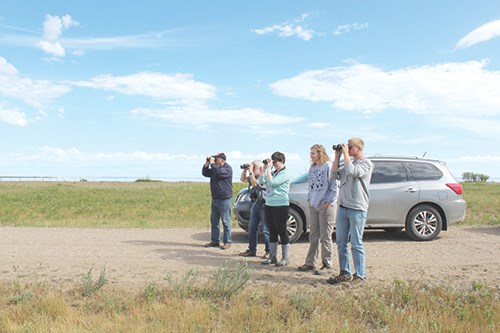The Old Wives Lake Watershed Association and Nature Saskatchewan teamed up for a bird count at Old Wives Lake and surrounding area on June 21. The bird count takes place twice a year in spring and fall. Jordan Rustad, an Important Bird Areas Project summer student, and Cierra Wellington from OWLWA led a group of avid bird watchers from Gravelbourg, Moose Jaw and Assiniboia. They identified and observed grasslands and waterfowl birds at Old Wives Lake and surrounding area. Rustad recorded bird species and numbers which will be added to the Saskatchewan Bird Atlas data.
The group observed birds at their nesting sites and feeding sights. The most common species were the red-winged and yellow-headed blackbirds and Meadow Lark. But the group also caught a sighting of the relatively rare Ibis and the Chestnut Collared Longspur which is actually endangered.
Some of the most exciting observations were of an owl family in an abandoned farm building and watching a Harrier Hawk out hunting. At the Old Wives Lake bird sanctuary, the group spent some time observing the spotted herons, ducks, Franklin Gulls and Eared Grebes with their distinctive ear tufts.
Out on the grass pasturelands, the group observed the Uplands Sandpiper, Eastern Kingbird, the brown cowbird following the herds, Horned Larks and numerous grasslands songbirds like the Sprague’s Pipet.
The Old Wives Lake Migratory Bird Sanctuary is just north of Mossbank. It was created in 1925 and the single permanent island in the lake is protected as a Game Preserve by the Province of Saskatchewan. Old Wives Lake is a terminal water body of a large, closed-basin watershed. Without an outlet stream, the lake concentrates salts over time, and the current salinity is too high to support fish or many submergent aquatic plants. Adjacent uplands are mostly native mixed-grass prairie, with little annual cropland near the shore. The lake area is a nesting and feeding grounds for many bird species.
The Old Wives Lake MBS is recognized as an important bird area by Bird Life Canada. Under the Species at Risk Act, the MBS protects critical habitat for the Piping Plover, a threatened species. It is also an important site of shorebirds in the Western Hemisphere.



